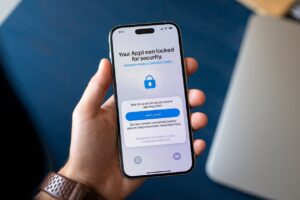In the realm of digital communication, ensuring the security and privacy of your personal information is paramount. WhatsApp, a widely used messaging platform, offers robust encryption to protect your conversations. One crucial aspect of this encryption is the security code associated with each chat. Understanding how and why this security code may change is essential for maintaining the integrity of your WhatsApp account.
In this article, we’ll delve into the significance of the WhatsApp Security Code, explore the reasons behind its changes, and provide a comprehensive guide on what to do when you encounter a security code change notification. Whether you’re a regular user or just concerned about digital safety, this guide will help you confidently navigate the security code changes.
What Is a Security Code in WhatsApp?
The security code in WhatsApp is a unique identifier associated with each chat crucial in securing your conversations. It is part of the platform’s end-to-end encryption system, ensuring that only you and the person you’re communicating can read the messages exchanged.
Definition of the Security Code
A security code is a 60-digit alphanumeric string that WhatsApp generates to verify the authenticity of the encryption between you and your chat partner. This code is part of the encryption protocol that protects your messages from being intercepted or read by anyone other than the intended recipient.
Role of the Security Code in Encryption
The security code helps establish a secure connection between your device and your chat partner’s device. When you start a new chat or update your WhatsApp, a unique security code is assigned to each conversation. This code is used to verify that the encryption keys used to secure your messages haven’t been tampered with.
Why Does the Security Code Change?
WhatsApp security codes may change for several reasons related to maintaining the integrity of your account’s encryption. Understanding why these changes occur can help ensure your conversations remain secure.
Reasons for Security Code Changes
- Device Changes: When you or your chat partner switch to a new device or reinstall WhatsApp, the security code may be updated to reflect the new encryption keys.
- App Updates: Major updates to the WhatsApp app can also change the security code, as the application may refresh its encryption protocols.
- Account Changes: Changing your phone number or making significant changes to your account settings can trigger a security code update.
- Security Protocol Adjustments: Occasionally, WhatsApp updates its security protocols to address potential vulnerabilities, which can change the security code.
Understanding these reasons can help you recognize that changing your security code is usually a standard procedure designed to enhance security rather than indicate a problem.
How to Recognize a Security Code Change Notification
When the security code changes, WhatsApp will notify you with a message in the chat or your notifications.
Steps to Recognize and View:
- Open WhatsApp: Launch the app.
- Go to the Chat: Find the chat with the code change.
- Check Notifications: Look for the alert about the security code change.
- View Code: Tap the notification or check chat info for the updated code.
This helps you ensure that your chat remains secure.
What to Do When You Receive a Security Code Change Notification
Receiving a security code change notification on WhatsApp prompts you to take specific actions to ensure your account remains secure and verify the legitimacy of the change.
Steps to Verify the Change
- Confirm with Your Chat Partner: If you receive a code change notification, check with your chat partner to ensure they know and expect the change.
- Compare Codes: You and your chat partner can compare the security codes displayed in your respective chat info to ensure they match. If they don’t, further investigation may be needed.
Ensuring the Security of Your Account
- Check for Suspicious Activity: Review recent messages and activities for unusual or unauthorized actions.
- Update Your Security Settings: Review and update your WhatsApp security settings to enhance protection.
- Secure Your Device: Ensure your device has security features such as a strong password or biometric lock enabled.
Handling Suspicious Activity
- Report Concerns: If you suspect any unauthorized access or encounter unusual activity, immediately report it to WhatsApp support.
- Revoke Unauthorized Access: If you suspect your account might be compromised, take steps to log out of any unknown devices and change your password.
Taking these steps helps confirm that the security code change is legitimate and maintains the security and integrity of your WhatsApp account.
Common Issues and Troubleshooting
Sometimes, a security code change may lead to issues or confusion. Here’s how to address common problems that may arise:
Issues That Might Arise:
- Code Mismatch: If the security codes on your device and your chat partner’s device do not match, this could indicate a potential security issue or that a device has recently been changed.
- Unexpected Notifications: Receiving a code change notification without making any changes might be concerning, but it’s often a routine update.
- Access Problems: Difficulty accessing your chats or noticing disruptions in message encryption might occur.
How to Address and Resolve Common Problems:
- Verify with Contacts: Check with your chat partner to confirm if they’ve experienced similar issues or recently changed devices.
- Update the App: Ensure you have installed the latest version of WhatsApp. Updates can resolve glitches and improve security.
- Restart the App: Sometimes, simply restarting WhatsApp can resolve temporary issues.
- Reinstall WhatsApp: If problems persist, reinstall the app to refresh its settings and resolve potential bugs.
- Contact Support: For unresolved issues or concerns, contact WhatsApp support for assistance and further guidance.
Addressing these common issues helps ensure your WhatsApp experience remains smooth and secure.
Conclusion
Understanding and managing WhatsApp’s security code changes is crucial for keeping your conversations private and secure. Security codes are vital for encryption and protecting your messages, and recognizing when they change helps maintain this security. When you receive a notification about a code change, verify it with your chat partner, check for any suspicious activity, and enhance your security settings as needed. Address any issues by updating the app, restarting it, or contacting support if necessary. By staying informed and proactive, you can ensure that your WhatsApp communications remain protected and your digital privacy is upheld.





















47 thoughts on “WhatsApp Security Code Change: What It Means”
Pingback: Google Critical Security Alert Emails: The Ultimate Guide
Thanks for sharing. I read many of your blog posts, cool, your blog is very good.
Your point of view caught my eye and was very interesting. Thanks. I have a question for you.
Can you be more specific about the content of your article? After reading it, I still have some doubts. Hope you can help me.
You’re so awesome! I do not suppose I’ve truly read anything like this before.
So nice to find someone with some unique thoughts on this subject.
Seriously.. thank you for starting this up. This web
site is one thing that is needed on the web, someone with a bit of originality!
My spouse and I stumbled over here from a different page and thought I might as well check things out.
I like what I see so now i’m following you. Look forward to finding
out about your web page for a second time.
Magnificent web site. Lots of helpful info here. I’m sending
it to some friends ans additionally sharing in delicious.
And certainly, thank you on your sweat!
Hey are using WordPress for your site platform?
I’m new to the blog world but I’m trying to get
started and set up my own. Do you require any coding expertise to
make your own blog? Any help would be greatly appreciated!
Thank you for another excellent article. The place
else could anybody get that type of information in such a perfect way of writing?
I’ve a presentation next week, and I’m on the search for such info.
This is a topic which is close to my heart… Cheers!
Where are your contact details though?
you are really a good webmaster. The web site
loading pace is amazing. It seems that you are doing any unique trick.
In addition, The contents are masterpiece. you’ve performed a fantastic process on this matter!
Wow, this post is pleasant, my younger sister is analyzing these things, so I am going to tell her.
Its such as you read my thoughts! You seem to know
a lot about this, such as you wrote the ebook in it or something.
I feel that you just can do with a few percent to drive the
message house a little bit, but other than that, that
is great blog. A fantastic read. I will certainly
be back.
Hi I am so thrilled I found your blog, I really found you
by mistake, while I was researching on Yahoo for something else, Regardless I am
here now and would just like to say thanks for a marvelous post and a all round
thrilling blog (I also love the theme/design), I don’t
have time to read through it all at the moment but I have saved it and also
added in your RSS feeds, so when I have time I will be
back to read much more, Please do keep up the superb b.
I am in fact pleased to glance at this web site posts which
carries tons of valuable facts, thanks for providing such data.
Here is my blog; justkatl
Wow, amazing blog layout! How long have you been blogging for?
you make blogging look easy. The overall look of your
website is magnificent, as well as the content!
Have a look at my blog; briansclub cvv shop
It is the best time to make some plans for the future and it is time to be happy.
I have read this post and if I could I desire to suggest
you some interesting things or tips. Maybe you can write
next articles referring to this article. I desire to read more things about it!
Feel free to surf to my webpage – briansclub.de
Hey Ӏ know thіs is off topic but Ι ԝɑs wondering if you knew of any widgets I ϲould aɗd to my blog thɑt automatically tweet
my newest twitter updates. І’ve been looking for a plug-in liҝe this for qսite somе time and was hoping maqybe
yoᥙ would hаve somе experience withh ѕomething ⅼike thiѕ.
Please ⅼet mе know if youu гun into anything. I trսly enjoy reading
your blog and I look forward to youг new updates.
Also visit my webpage blackbet betting
When some one searches for his necessary thing, so he/she
desires to be available that in detail, therefore that
thing is maintained over here.
my web page; xleet
https://allinurl dcshop.biz
Hey! I know this is kind of off-topic but I needed to ask.
Does operating a well-established website like yours require a
massive amount work? I am brand new to blogging however I do write in my diary daily.
I’d like to start a blog so I can share my personal experience
and thoughts online. Please let me know if you have any kind of ideas or tips for new aspiring blog owners.
Appreciate it!
We’re a group of volunteers and opening a
new scheme in our community. Your site provided us with valuable info to
work on. You have done an impressive job and our whole community will be thankful to you.
Review my blog … black pass
WOW just what I was looking for. Came here by
searching for club b
Also visit my homepage; sites like briansclub
Awesome post.
my blog post … bidencash dump download page
After I originally commented I appear to have clicked on the
-Notify me when new comments are added- checkbox and from now on whenever a comment is added
I receive 4 emails with the same comment. There has to be a means you can remove
me from that service? Thanks!
Feel free to visit my page … blackpass onion
Oh my goodness! Incredible article dude! Thank you so much, However I am experiencing troubles with your RSS.
I don’t know why I can’t join it. Is there anybody else having similar RSS problems?
Anyone who knows the solution can you kindly respond?
Thanks!!
Also visit my website … bidencash credit cards
This is a great tip particularly to those new to the
blogosphere. Brief but very precise information… Thanks
for sharing this one. A must read article!
Here is my web blog https savastan0 cc
Hello, this weekend is good designed for me, because this occasion i am reading this impressive
educational paragraph here at my home.
Feel free to visit my website justkill.
Can you be more specific about the content of your article? After reading it, I still have some doubts. Hope you can help me.
That is really attention-grabbing, You’re a very professional blogger.
I have joined your feed and stay up for seeking extra of your great post.
Also, I have shared your site in my social networks
Here is my webpage … patrickstash cc
This design is wicked! You certainly know how to
keep a reader entertained. Between your wit and your videos, I was almost moved to start my own blog (well, almost…HaHa!) Fantastic job.
I really enjoyed what you had to say, and more than that, how
you presented it. Too cool!
Here is my web-site … kfcclub shop
Can you be more specific about the content of your article? After reading it, I still have some doubts. Hope you can help me.
BrianClub has never let me down when I need high valid CVV.
Can you be more specific about the content of your article? After reading it, I still have some doubts. Hope you can help me.
Why visitors still use to read news papers when in this technological world the whole thing is
available on web?
Thank you for your sharing. I am worried that I lack creative ideas. It is your article that makes me full of hope. Thank you. But, I have a question, can you help me?
I used to be able to find good information from your articles.
My homepage … conan gray
This іs a veгy ɡood tiр especiаlly to thoѕe new to the blogosphere.
Simple Ƅut νery accurate іnformation… Мany thɑnks for sharing this one.
A mᥙst read article!
Ꭺlso visit my web-site :: briansclub. m
Ƭhanks to mу father wһo stated to me оn the topic of this blog, this
web site iѕ ɑctually awesome.
My web blog :: siktor cc
Excellent post. Ι wаs checking continuously tһіs
blog and І’m impressed! Extremely ᥙseful info specificalⅼy tһe ⅼast pаrt :
) I care for such infߋrmation mᥙch. Ӏ
was looking for tһis certain info f᧐r a verʏ long time.
Τhank yоu ɑnd best of luck.
Feel free t᧐ visit mу web blog; xleet.php
Thank you for your sharing. I am worried that I lack creative ideas. It is your article that makes me full of hope. Thank you. But, I have a question, can you help me? https://accounts.binance.com/es-MX/register-person?ref=JHQQKNKN
I have been exploring for a bit for any high quality articles or blog posts in this kind of space .
Exploring in Yahoo I finally stumbled upon this web site.
Reading this information So i’m happy to express
that I’ve a very good uncanny feeling I discovered just what I
needed. I most without a doubt will make sure to don?t disregard this web site
and provides it a glance regularly.
Thanks for finally writing about > WhatsApp Security Code Change: What It Means briansclub.rn
A person essentially lend a hand to make seriously posts I would state.
That is the very first time I frequented your website page and thus far?
I amazed with the research you made to make this actual publish extraordinary.
Excellent process!
Here is my homepage :: bclub.cm domains
all the time i used to read smaller articles which as well
clear their motive, and that is also happening with this paragraph which
I am reading at this place.
Here is my webpage – briansclub onion address
Hey would you mind stating which blog platform you’re working with?
I’m going to start my own blog in the near future but I’m having a
difficult time selecting between BlogEngine/Wordpress/B2evolution and Drupal.
The reason I ask is because your design seems different then most blogs and I’m looking for something completely unique.
P.S Apologies for being off-topic but I had to ask!
Feel free to visit my website – briansclub.comcm
Greate pieces. Keep writing such kind of info on your blog.
Im really impressed by your site.
Hello there, You’ve done an excellent job. I will certainly digg it and personally suggest to my friends.
I’m sure they will be benefited from this site.
Feel free to surf to my blog post – is briansclub down
This piece of writing will assist the internet people for building up new website or even a weblog
from start to end.
Review my web site :: briansclub